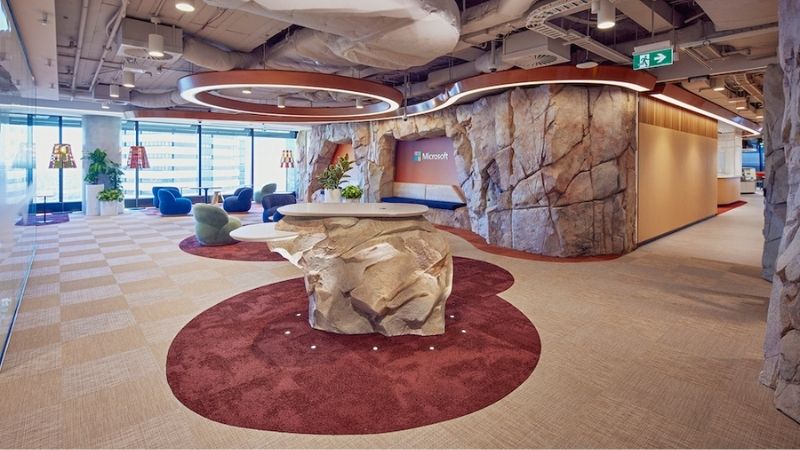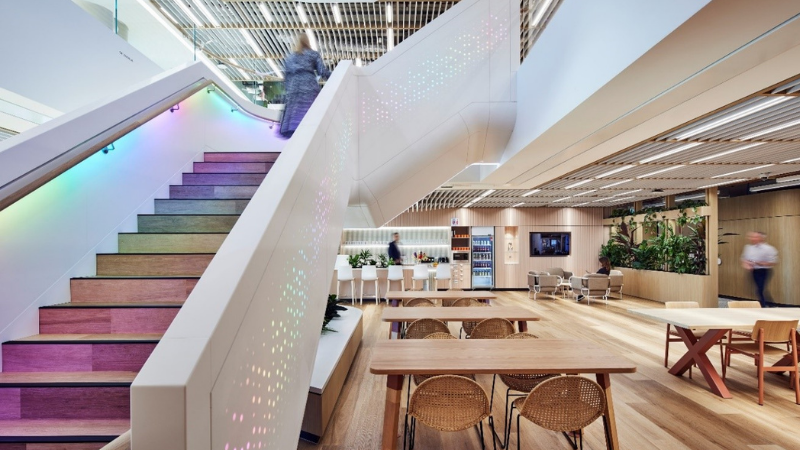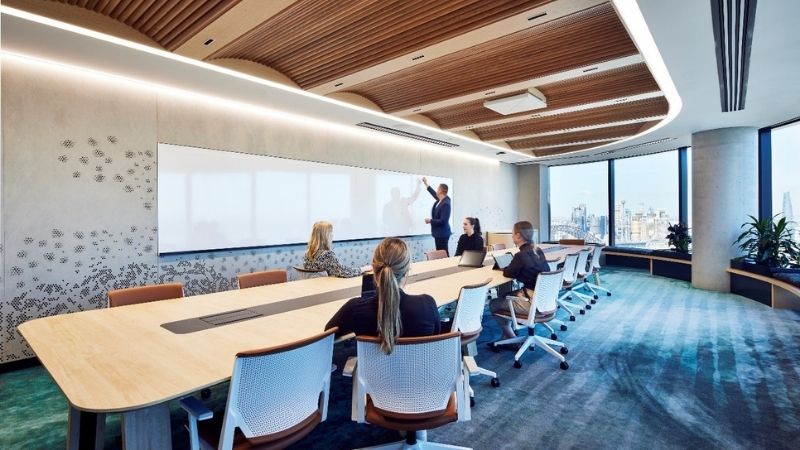Microsoft’s New Headquarters Redefines Workplaces
Microsoft Australia’s new headquarters is setting the benchmark for hybrid workplaces of the future, breaking the traditional mould and designing for those not in the room.
Located in Sydney’s emerging technology and media hub, Microsoft is in good company at 1 Denison—North Sydney’s smartest office tower and first PCA Premium Grade asset.
Digital innovations, quiet spaces, open meeting areas, a library, nap suites, prayer rooms, and a leisure hub for employees to enjoy a game of pool, ping pong, or darts. These are just some of the features available at Microsoft’s new collaborative workplace, which was created in partnership with global design studio GroupGSA.
Spanning seven floors, the office offers employees and clients varying spaces to work collaboratively, create meaningful partnerships and find inspiration with advanced technology at the centre of all interaction.
“The new headquarters is a magnet for our clients, partners and community. It’s a place for them to discover how Microsoft and technology can help them transform and achieve their ambitions,” Ashish Mehrotra, Microsoft’s regional portfolio lead for APAC and ANZ, said.
“Covid-19 has taught businesses that distance is no longer a barrier to connectivity, engagement, and productivity. It is also no barrier to having a thriving company culture.”
Since the pandemic forced us to return, and stay, at our make-shift home offices, more than 70 per cent of respondents, including the Australian workforce, have said that they want flexible work options to stay, according to a survey conducted by Microsoft.
Alternatively, more than 65 per cent want more in-person time with their teams.
The research also shows that to prepare, 66 per cent of businesses are considering redesigning physical spaces to accommodate hybrid work environments.
The evidence is clear: flexibility and hybrid work will define the future workplace.

Microsoft has been studying remote work since the early 1990s and has always believed in a hybrid future. This is clearly shown in the design of the new space, where remote and in-person workers are on equal footing.
“Our Sydney office was designed to support employee collaboration and innovation,” Mehrotra said. “It is a place where they can do their very best work and include customers in shaping today’s transformational innovations and technologies.
“From every angle, it reflects our company’s commitment to enabling every person and organisation to achieve more.”
A new digital workspace
There is still a significant need and desire for in-person collaboration. Employees want to come together and connect—and level 27 is precisely for that.
An open space, concierge at arrival, communal dining, an onsite barista, and grab-and-go food options prompt people to chat, eat, collaborate, and socialise. There are also areas for board games, a spot where workers can get support for technical problems, and flex spaces that adapt to varying purposes, including sports watching night.
“We deliberately placed the customer-focused sites at the heart of the building on levels 27 and 28. This puts visitors in the middle of our workplace energy and community and includes them as part of the action,” John Bowden, Microsoft’s senior workplace strategist for Asia, said.
User experience is at the centre of the new Sydney office. The company has enhanced its digital offerings to streamline and improve an occupant’s day-to-day movement.
For instance, the 1 Denison building app allows employees to book services, register for events, order food, and more.
Other examples of Microsoft’s new advanced technology include:
Occupancy sensors to view the utilisation of a specific room on a real-time basis.
Altoura technology creates full-scale 3D modelling of the space using spatial computing, enabling a collaborative design and user engagement process amidst the challenges of a pandemic and working with remote stakeholders.
Smart lockers that allow users to access and reserve the lockers with a mobile app, helping manage occupancy ebb and flow.
The ability to book and pay for all common amenities in the building through an application.
Modern facility management, including cleaning robots.
Arrival and departure kiosks that act as a virtual concierge, giving visitors self-service check in and access to transport, dining and site services.
Collaboration powered by rich technology is a key part of the hybrid office experience. With the introduction of many new features, including smart office sensors and digital whiteboards, the inclusions allow everyone to contribute in the way that best suits them—whenever, wherever.
A real commitment
Employees work best when their wellbeing is front and centre. The space prides itself on its commitment to health and wellbeing, featuring purpose-built amenities to ensure employees can exercise when it suits them.

Nest, 1 Denison’s exclusive and holistic wellness amenity, offers exercise classe including yoga, reformer pilates, barre, interval training, and private physiotherapy, remedial massage and chiropractic services. All visits to Nest are managed through the 1 Denison app.
1 Denison also curates community events such as art classes, trivia nights and cultural workshops. On top of this, Microsoft’s people have access to healthy food options and retailers, and the pick of 570 secure bike spaces on site and proximity to public transport, encouraging a greener, more active commute.
In May 2020, 1 Denison was certified by the Green Building Council of Australia (GBCA) with a 5 Star Green Star rating.
Green Star assesses the sustainable design, construction and operation of buildings and fit-outs, helping to minimise their operational costs and carbon footprint.
The Microsoft headquarters is also designed to meet the green standards. The building is currently targeted 5 Star NABERS Energy Rating and a Platinum WELL Rating. 1 Denison has partnered with Microsoft and other tenancies to deliver a waste management plan, which strives toward a 0% landfill rate.
Other sustainable considerations include indoor plants, smart lighting, bridgeable packaging and containers, and coffee recycling bins.
The office also actively supports people with vision and mobility impairments, whether permanent or temporary.
Braille script identifies meeting rooms and pantry items, drawer pulls are grip friendly, talking microwaves in the kitchen, doors have handles or push bars, and conference rooms have one-touch meeting starts.
There are also easily moveable kiosks at lobbies and height inclusive reception desks. Spatial and circulation design also allows for motorised wheelchairs.
“Inclusion is a key cultural pillar of our values, and the Sydney office is one of our most inclusive and accessible sites,” Bowden said.
Microsoft Australia employees also had the opportunity to vote on furniture and several room names (except Indigenous names) and attend a food and beverage tasting event where they could sample a selection of the food and coffee that will be on offer at the grab-and-go station.
The unified workplace
The office, occupying up to 10,655sqm, will bring together employees from North Ryde, Oxford Street and WeWork offices in Sydney CBD.
Combining the four spaces will help the business strengthen its culture and boost team collaboration and innovation.
“We are working towards a strong One Microsoft culture: moving together, where all the different Microsoft businesses can be under one roof to be more cohesive and collaborative,” Mehrotra said.
“Microsoft Australia has created an environment that inspires our employees, customers and partners, while also showcasing the best of Microsoft’s technology and services.”

The new office brings Microsoft’s vision of an Intelligent Workplace to life by offering premium technology, innovation, cultural values, and inclusivity in a connected, collaborative, and dynamic space.
The office allows employees to connect with colleagues and clients in both a work sense (collaboration spaces, scrum areas, collaboration technology) and recreationally (events, leisure spaces, and social get-togethers).
1 Denison also organises a range of events – spanning sustainability, diversity and innovation to engage workers in the building and build a cohesive environment.
Spontaneity, collaboration and innovation
From floor 24 to 30, the area will serve as the main office for the Australian region and accommodate roughly 1400 employees. With the teams now co-located in one building, employees are no longer relegated to floor-defined offices or working in organisational silos.
The seven floors are connected by an open, central staircase that allows employees to circulate throughout the space, encouraging interactions and collaborations among teams and across functions.
The stairs also feature a technical lighting control system that simulates dynamic lighting movement. The lights change depending on the theme. Configurations include the Australian landscape, circadian rhythms and International Women’s Day; and RSS Feed AccuWeather, reacting in real-time, the lights showcase the day’s conditions.
Drawing on the Australian native landscape, the key office design elements include:
Rock wall—simulating Cradle Mountain
Parametric timber wall—Australian Royal National Parks figure eight pools
Floor finishes are themed to the landscape of each level
Reflective Rimex surface mimic the full immersion into Microsoft and as a nod to submerging or jumping into the Figure 8 Pools in Sydney
Further, each floor has many different work areas to suit employees’ diverse work needs. They can choose quiet corners for solo work, comfortable sofas for informal meetings, and reservable meeting rooms for more involved sessions.
Team neighbourhoods, screened-in workshop areas, touch-down desks, sound-proofed phone booths, and conversation rooms all work together to support today’s mobile workforce.
It’s time to rethink the employee experience
Every organisation moving forward will need a plan that will ensure a successful business future. It should start with answering one critical question: how are people doing and what do they need?
The office space is no longer just about ‘work’ and ‘productivity.’ It has become a place for culture, focusing on creating connections and setting purpose and values. It also allows employees to engage with leaders to understand strategies and share knowledge with colleagues.
Therefore, leaders must consider how to best equip all workers with the tools they need to succeed — whether they’re working from home, in the office, or on the go.
“Our new workplace will energise and empower us to do our best work every day while reflecting the Australian culture and spirit of innovation inherent in the Microsoft brand,” Mehrotra said.
The Urban Developer is proud to partner with Microsoft to deliver this article to you. In doing so, we can continue to publish our daily news, information, insights and opinion to you, our valued readers.














